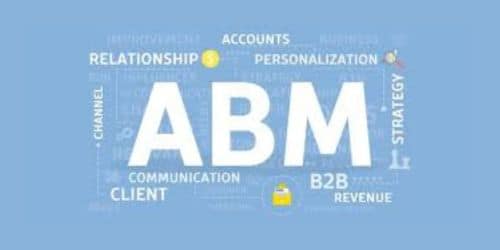Daily businesses try to uncover new ways of reaching out to more customers, increasing sales, becoming more productive, and also achieving their goals. Account based marketing (ABM) is a marketing strategy that focuses on going after the most lucrative prospects within the accounts that are the best fit for the company. Generally, the main difference between marketing and ABM is the level of personalization and targeting involved. ABM is a more focused and customized approach that is designed to establish stronger relationships with high-value accounts and increase the chances of closing deals. Let’s see what account based marketing is about, how it works as well as software that makes the process easy.
Account Based Marketing B2B
Account-based marketing (ABM) is a B2B marketing strategy that focuses on targeting specific accounts or companies, rather than targeting a broader audience. ABM involves identifying high-value target accounts, creating personalized marketing campaigns for those accounts, and using a range of channels to reach decision-makers within those companies.
ABM is often used in B2B marketing because it allows companies to focus their resources and efforts on high-value accounts, which can result in a higher ROI. By creating personalized campaigns and messaging for each account, companies can establish stronger relationships with their target customers and build brand awareness within those accounts.
Experts and professionals believe that ABM is a powerful B2B marketing strategy that can help companies to achieve better results by focusing their efforts on high-value accounts and building stronger relationships with key decision-makers
To implement ABM, B2B companies typically follow these steps:
#1. Identify Target Accounts
Identify the high-value accounts that are most likely to benefit from your products or services.
#2. Gather Data
Collect data on the target accounts, including their pain points, challenges, and business goals.
#3. Create Personalized Campaigns
Create customized campaigns for each target account, based on the data collected.
#4. Use a Range of Channels
Use a variety of channels to reach decision-makers within the target accounts, including email, social media, direct mail, and events.
#5. Measure and Refine
Track the performance of the campaigns and refine the approach as needed to improve results.
What Is the Role of Account-Based Marketing?
The role of account-based marketing (ABM) is to help B2B companies identify, engage, and convert high-value accounts into long-term customers. The traditional marketing approach is to target a broad audience with a one-size-fits-all message, but ABM takes a more targeted and personalized approach.
Types Of Account Based Marketing
The following are the types of account based marketing strategies:
#1. Strategic ABM
Strategi ABM is also known as One-to-One ABM. This is the most personalized form of ABM and involves targeting a small number of high-value accounts with highly tailored messaging and outreach. The goal is to build deep, long-term relationships with key decision-makers within these accounts.
#2. ABM Lite
ABM lite is also known as One-to-Few ABM. This form of ABM involves targeting a slightly larger group of accounts with similar characteristics and needs. The messaging and outreach are still highly personalized, but the campaigns may be less intensive than in strategic ABM.
#3. Programmatic ABM
Programmatic ABM is also known as One-to-Many ABM. This form of ABM involves targeting a larger group of accounts with similar characteristics and needs but still tailoring messaging and outreach to those accounts. The campaigns may be more automated and scaled than in the other forms of ABM, but still personalized enough to resonate with the target accounts.
Specific Roles Of ABM
The specific roles of ABM include helping companies focus their marketing and sales efforts on the accounts that are most likely to drive revenue growth and build strong personalized relationships with key decision-makers within those accounts. The following are the diverse roles ABM plays in businesses
#1. ABM Helps Companies
Identify high-value accounts: ABM enables companies to identify the accounts that are most likely to drive revenue growth and align with their ideal customer profile.
#2. Build Personalized Relationships
ABM helps companies build personalized relationships with key decision-makers within target accounts by tailoring messaging and outreach to their specific needs and interests.
#3. Create Targeted Campaigns
ABM allows companies to create highly targeted and personalized campaigns that resonate with individual decision-makers, rather than sending a generic message to a broad audience.
#4. Align Sales and Marketing Efforts
ABM requires strong alignment between sales and marketing teams to identify target accounts, develop personalized campaigns, and track progress toward shared revenue goals.
#5. Improve Conversion Rate
By targeting high-value accounts with personalized messaging and tailored campaigns, ABM can help improve conversion rates and drive revenue growth.
What Are the Three Types of Account-Based Marketing?
There are three main types of account-based marketing (ABM):
- ABM Lite
- Strategic ABM
- Programmatic ABM
What Are the Key Elements of Account-Based Marketing?
The key elements of account-based marketing (ABM) can be broken down into four main components. These are account selection, personalized messaging, multi-channel campaigns, and sales and marketing alignment.
Elements Of Account-Based Marketing
The following are the elements of account-based marketing:
#1. Account Selection
The first step in ABM is to identify the high-value accounts that are most likely to drive revenue for your business. This involves analyzing data to determine which accounts have the greatest growth potential, as well as which accounts align with your ideal customer profile.
#2. Personalized Messaging
Once you have identified your target accounts, the next step is to create personalized messaging that speaks directly to the needs and pain points of individual decision-makers within those accounts. This could involve customized content, messaging, and outreach strategies designed to resonate with the specific needs and interests of each account.
#3. Multi-Channel Campaigns
ABM involves creating campaigns that reach decision-makers across multiple channels, including email, social media, digital advertising, and more. The goal is to create a cohesive and personalized experience that engages decision-makers at every stage of the customer journey.
#4. Sales and Marketing Alignment
Finally, ABM requires strong alignment between sales and marketing teams. Both teams need to work together to identify target accounts, develop personalized campaigns, and track progress toward shared revenue goals. This involves regular communication and collaboration to ensure that all efforts are aligned and focused on driving revenue growth from high-value accounts.
What Is Account-Based Marketing Also Known As?
Account-based marketing (ABM) is also known as key account marketing, strategic account marketing, or named account marketing. These terms are often used interchangeably to describe the same approach of targeting high-value accounts with personalized marketing campaigns
What is the Difference Between Marketing and Account-based Marketing?
The key difference between marketing and account-based marketing (ABM) is the level of personalization and targeting involved.
In traditional marketing, companies often cast a wide net and try to appeal to as many potential customers as possible. The messaging and tactics used are often more general and may not be tailored to the specific needs or pain points of individual customers.
In contrast, ABM is a much more targeted approach that focuses on specific high-value accounts. The goal of ABM is to create personalized campaigns and content that speak directly to the needs and pain points of individual accounts. This could include customized messaging, personalized content, and tailored outreach strategies designed to resonate with decision-makers within the target account.
Another key difference between marketing and ABM is the role of sales and marketing teams. In traditional marketing, sales and marketing teams often operate separately, with marketing generating leads and passing them off to sales. In ABM, sales and marketing teams work together more closely to identify target accounts, create personalized campaigns, and close deals.
What is an Example of Account Based Marketing?
Here’s an example of how account-based marketing (ABM) might work in practice:
Let’s say you’re a B2B software company that provides a customer relationship management (CRM) platform. You’ve identified a few key target accounts that you think would be a great fit for your product.
Using ABM, you would start by doing some research on those target accounts. You might look at their website, read their blog, and follow them on social media to get a better sense of their pain points and challenges. You might also look at their financials to see how much they spend on technology and software.
Based on this research, you might create some personalized marketing materials specifically for those target accounts. For example, you might create a case study that shows how your CRM platform helped a similar company overcome a specific challenge. Or, you might create a personalized video that speaks directly to the target account’s pain points and how your product can help.
Next, you would use a variety of channels to reach decision-makers within those target accounts. This might include personalized email campaigns, targeted social media ads, and even direct mail campaigns. You might also attend industry conferences and events where you know decision-makers from those target accounts will be present.
Throughout the process, you would measure and refine your approach based on what’s working and what’s not. For example, if you find that your email campaigns are getting a lot of engagement but your direct mail campaigns aren’t, you might shift more of your budget to email.
By focusing your marketing efforts on specific high-value accounts, and tailoring your messaging and campaigns to their needs, you can build stronger relationships with those customers and increase your chances of closing deals with them. This is the essence of account-based marketing.
Account Based Marketing Strategy
Account-based marketing (ABM) is a B2B marketing strategy that involves targeting high-value accounts or companies and creating customized marketing campaigns to engage decision-makers within those accounts.
Steps to Effective Account Based Marketing Strategy
Effective account based marketing strategy will target high-value accounts and create personalized campaigns, ABM can help you to establish stronger relationships with decision-makers, generate higher-quality leads, and improve your overall return on investment (ROI).
The following are some key steps to creating an effective ABM strategy:
#1. Research and Gather Data
Gather information about the accounts, including their business objectives, challenges, and decision-makers.
#2. Measure and Refine
Track the performance of your campaigns and adjust your approach as needed to improve results and better engage target accounts.
#3. Identify High-value Accounts
Work with your sales team to identify accounts that are most likely to generate revenue and align with your company’s goals.
#4. Leverage Multiple Channels
Use a variety of channels to engage decision-makers within each account, including email, social media, direct mail, and events.
#5. Create Buyer Personas
Develop buyer personas for the key decision-makers within each account to understand their motivations, pain points, and buying preferences.
#6. Develop Customized Messaging and Campaigns
Based on the information gathered, create personalized messaging and campaigns that address the specific needs and pain points of each account.
Account Based Marketing Software
There are several account-based marketing (ABM) software solutions available on the market today. When choosing an ABM platform, it’s important to consider your specific needs and budget to select the best solution for your business.
The following are some popular options:
#1. Terminus
The first account based marketing software on our list is Terminus. Terminus is a comprehensive ABM platform that offers a range of features, including account identification, advertising, web personalization, and sales intelligence.
#2. Demandbase
Demandbase is a leading ABM platform that offers a range of solutions, including account identification, advertising, website personalization, and sales enablement.
#3. RollWorks
RollWorks is an ABM platform that offers account-based advertising, lead generation, and sales automation features.
#4. Engagio
Next on our list of account based marketing software is Engagio. This is an ABM platform that offers account-based advertising, sales enablement, and analytics features.
#5. Kwanzoo
Kwanzoo is an ABM platform that offers account-based advertising, web personalization, and lead generation features.
#6. Jabmo
The last account based marketing software on our list is Jabmo. Jambo is an ABM platform that offers account-based advertising, web personalization, and sales enablement features.
- BEHAVIORAL TARGETING: Guide To The Processes
- Saas Sales: Ultimate Guide to The Saas Sales Process and Metrics(Opens in a new browser tab)
- WHAT IS ACCOUNT BASED MARKETING: Top Strategies, Companies, Framework, & Difference
- WHAT IS ACCOUNT BASED MARKETING: Top Strategies, Companies, Framework, & Difference
- CRM MARKETING: What Is It, Examples & Strategy






